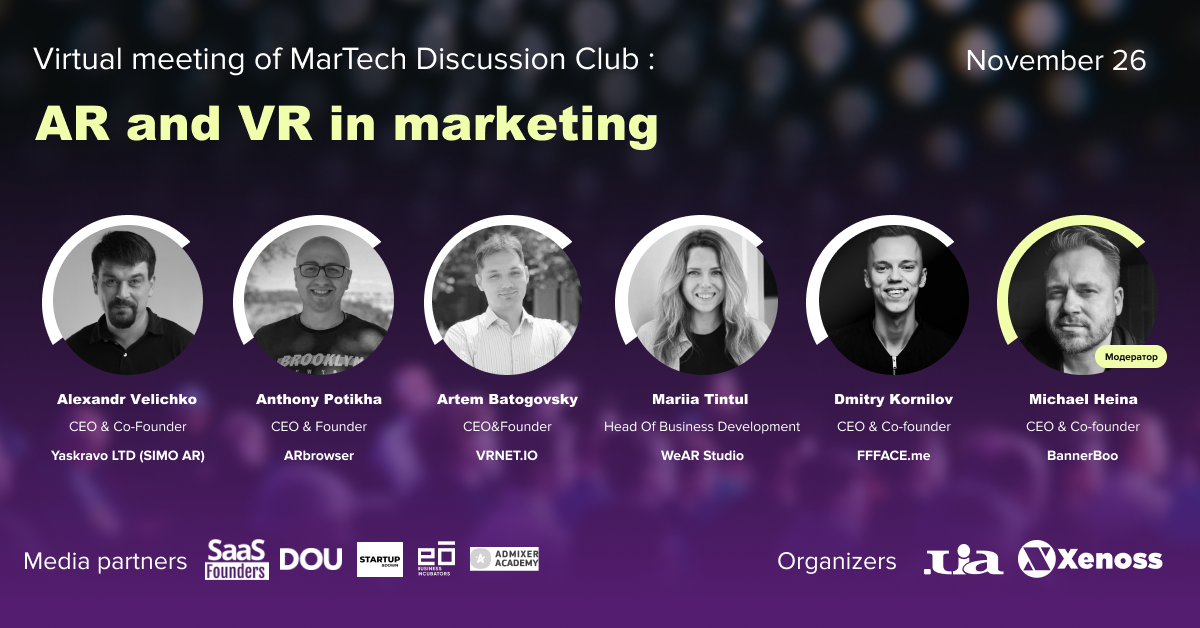On November 26, we organized our sixth virtual meetup of the MarTech Discussion Club dedicated to VR and AR in marketing. The event was organized in partnership with UIA.
MarTech Discussion Club exists to bring the local MarTech and AdTech communities together to exchange ideas, experiences, and knowledge.
Our virtual panel composed of representatives of leading AR and VR companies in Ukraine shared thoughts on the current state of AR and VR, exchanged opinions on the trends in the industry, talked about successful cases of AR and VR in marketing, and finally made predictions on what awaits the technology in the future.
At this virtual meetup our speakers were:
Alexandr Velichko, CEO & Co-Founder at Yaskravo (SIMO AR)
Anthony Potikha, CEO & Founder at ARbrowser.co
Artem Batogovsky, CEO & Founder at VRNET
Mariia Tintul, Head of Business Development at WeAR Studio
Dmitry Kornilov, CEO & Co-founder at FFFACE.ME
Down below we will go into the key takeaways from the meetup. If you’re interested in hearing the full discussion, you can watch the recording.
AR and VR aren’t new technologies, but there’s still that feeling of innovation around them. You can already find brands successfully using these technologies in marketing. Yet there’s a lack of understanding surrounding AR and VR.
AR and VR are not one and the same. You have to look at each technology and each use case separately and whether or not it fits business goals and consumer habits. Our speakers agreed that when applying these technologies to marketing, it shouldn’t be taken out of the context of a product. There has to be a call-to-action and a story behind it, to seamlessly integrate it with the product.
Nowadays, there are already industries for which AR and VR have become must-haves. Good examples are real estate and construction companies for which the technology became a standard use.
There are other industries where AR and VR have seen a lot of success, such as navigation, gaming, communications (social media e.g. Instagram, Facebook, Tiktok etc.), and retail (makeup, furniture, etc).
Alexandr Velichko pointed out that the art industry had also seen an influx of AR and VR use. In his experience, museums that implemented virtual technology during the pandemic saw an increase of 30% in visitors after the lockdown.
Overall, the COVID-19 lockdown made people more open to VR and AR. While there were a lot of events canceled and travel restrictions are still in place, brands had to find ways to engage customers. During the lockdown, visualizations, and interactions with the external world for consumers are the most important features that brands can develop.
At the same time, brands shouldn’t be mindlessly chasing the hype. There has to be a solid place for AR or VR to be integrated into the product journey. If there is no need for it, there is no point in adding it.
Companies that have already implemented VR and AR into their marketing shouldn’t shy away from the standard metrics which are applied in marketing. Just because it’s a trendy technology, it shouldn’t be exempted from effectiveness metrics.
To stay informed about our future events and company news, follow us on Facebook or LinkedIn. Join our community of MarTech experts!
